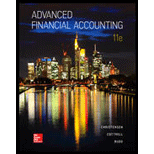
Concept explainers
(a)
Introduction: The cost of goods sold refers to the cost of acquisition or manufacturing of goods that a company sells during a particular period. The cost of goods sold includes the cost of materials and labor used in the manufacturing and other associated costs.
The cost of goods to be reported in the consolidated financial statements in 20X9
(b)
Introduction: Inventory refers to the goods that a business holds with the ultimate goal of resale. It includes only the finished goods or unfinished goods to be ultimately used in the production process. It is classified as a current asset in the
Inventory balance to be reported in the consolidated balance sheet
(c)
Introduction: A non-controlling interest refers to an ownership position in which the shareholders hold less than 50 percent of the total shares in the company and have no control over its decisions.
The amount to be reported in the consolidated income statement as income assigned to non-controlling interest
(d)
Introduction: A non-controlling interest refers to an ownership position in which the shareholders hold less than 50 percent of the total shares in the company and have no control over its decisions.
The amount to be reported in the consolidated balance sheet as income assigned to non-controlling interest.
(e)
Introduction:
The amount of retained earnings to be reported in the consolidated balance sheet.
(f)
Introduction:
Consolidation entries required to prepare three-part consolidated worksheet at December 31, 20X9.
(h)
Introduction: A consolidated worksheet is used to prepare the consolidated financial statements of the parent company and its subsidiary. It reflects the individual values of the parent and the subsidiary and then one consolidated figure for both the entities.
Three part consolidation work paper for 20X9
Want to see the full answer?
Check out a sample textbook solution
Chapter 6 Solutions
Advanced Financial Accounting
- What is riverdale company's total equity?arrow_forwardI am searching for the correct answer to this general accounting problem with proper accounting rules.arrow_forwardBentley Enterprises estimated manufacturing overhead for the year at $420,000. Manufacturing overhead for the year was overapplied by $25,000. The company applied $380,000 to Work in Process. The amount of actual overhead would have been_____.arrow_forward
- I need help with this general accounting question using standard accounting techniques.arrow_forwardGrunewald Industries sells on terms of 3/10, net 40. Gross sales last year were $4,161,000 and accounts receivable averaged $370,500. Half of Grunewald's customers paid on the 10th day and took discounts. What are the nominal and effective costs of trade credit to Grunewald's nondiscount customers? (Hint: Calculate daily sales based on a 365-day year, calculate the average receivables for discount customers, and then find the DSO for the nondiscount customers.) Do not round intermediate calculations. Round your answers to two decimal places. Nominal cost of trade credit: % Effective cost of trade credit: %arrow_forwardPlease provide the accurate answer to this financial accounting problem using appropriate methods.arrow_forward

 AccountingAccountingISBN:9781337272094Author:WARREN, Carl S., Reeve, James M., Duchac, Jonathan E.Publisher:Cengage Learning,
AccountingAccountingISBN:9781337272094Author:WARREN, Carl S., Reeve, James M., Duchac, Jonathan E.Publisher:Cengage Learning, Accounting Information SystemsAccountingISBN:9781337619202Author:Hall, James A.Publisher:Cengage Learning,
Accounting Information SystemsAccountingISBN:9781337619202Author:Hall, James A.Publisher:Cengage Learning, Horngren's Cost Accounting: A Managerial Emphasis...AccountingISBN:9780134475585Author:Srikant M. Datar, Madhav V. RajanPublisher:PEARSON
Horngren's Cost Accounting: A Managerial Emphasis...AccountingISBN:9780134475585Author:Srikant M. Datar, Madhav V. RajanPublisher:PEARSON Intermediate AccountingAccountingISBN:9781259722660Author:J. David Spiceland, Mark W. Nelson, Wayne M ThomasPublisher:McGraw-Hill Education
Intermediate AccountingAccountingISBN:9781259722660Author:J. David Spiceland, Mark W. Nelson, Wayne M ThomasPublisher:McGraw-Hill Education Financial and Managerial AccountingAccountingISBN:9781259726705Author:John J Wild, Ken W. Shaw, Barbara Chiappetta Fundamental Accounting PrinciplesPublisher:McGraw-Hill Education
Financial and Managerial AccountingAccountingISBN:9781259726705Author:John J Wild, Ken W. Shaw, Barbara Chiappetta Fundamental Accounting PrinciplesPublisher:McGraw-Hill Education





